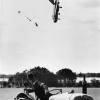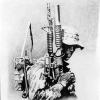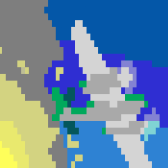Search the Community
Showing results for tags 'Miniwing'.
-
Some pictures of a Hawker Sea Hawk I finished. It is a relatively new styrene kit from the small Czech company Miniwing and I haven’t seen one built up elsewhere yet. It’s a nice kit overall. Very gratifying to build. It does benefit from a bit of refining here and there. For instance I bored out the exhausts which were q thick. I also rebuilt a tail hook from scratch. I think the hook bit is still a bit too large but then the kit one is elephantine. The resin Miniwing kit one was etch I recall. Apart from all the antenna which were obviously scratch built, I also added in the spent casing dispensers and the catapult hook under the nose from plasticard. I think the intakes I substituted (wedges of .5mm plasticard glued in place then trimmed) worked better than the kit parts which don't fit at all and mess up the upper/lower fuselage fit. That's the only change I'd positively recommend anyone attempting this kit do. I'm pleased with how transparent the cockpit is. Miniwing get good marks for that! I also think this largely captures the look of the Sea Hawk, and the stance on the ground. I thinned the undercarriage doors and glued the wheels in their characteristic 'instep' - though one is looking a bit too cock-eyed in this picture. I was pleased with my painting and weathering - I'm always amazed at how the matt coat knocks back the oils post-shading. I quite like the effect here. Thanks very much for looking. Angus
- 10 replies
-
- 30
-

-
Here is Miniwing's 1:144 Aeritalia (Fiat) G.91R/4 which I built in 2011. It represents 5429 of Esquadra 702 Escorpiões, Força Aerea Portuguesa, based at Boca de Tubarão, Mozambique, in 1970. It's a nice resin kit sadly let down by the poor printing resolution of the decals. I had to touch some of them up with paint, in particular the flags on either side of the tail. The kit was completely painted with brush with only the final varnish being airbrushed. Thank you for looking and all comments are welcome Miguel
-
Here's my Saab J35A Draken "19", of Flygflottilj 13, Swedish Air Force, NorrKöping, Sweden, early 1960s. It's the Miniwing resin 1:144 kit which I built in 2010. The kit was completely painted and varnished with brush. I used Humbrol 27002 Polished Aluminium for the main metallic finish and dry-brushed Humbrol 56 Flat Aluminium along panel lines. The markings are sadly poor because of the decals which Miniwing used to have. I had no alternative replacements so had to make do with them. Thanks for looking and comments are welcome. Miguel
-
My next entry in this group build is the MiniWing McDonnell CF-101 Voodoo, which actually is a re-release of an old FE-Resin kit. As usual, the kit comes in a cheap cardboard board with the only use of WordArt I've seen outside tacky flyers and parish newsletters: The fuselage is cast as a hefty single piece, though a piece of the tail was missing in the box (probably something wrong with the casting). The nose is a sepearate piece, probably because Miniwing also released an RF-101 with a different nose. The wings, nose and exhausts come on fairly inconvenient casting blocks, and it will be tricky to remove them cleanly. I will probably saw off a part of the casting block and file it off. Two vacuform canopies are provided, and I will need to break out a new scalpel blade for this. By the way, the tail's not warped as it seems in this picture, the fuselage isn't sitting perfectly flat. Strangely enough, only one seat is provided, and some pieces don't seem to have a place to be glued on to, like the two L-shaped blocks next to the part with the ventral strakes (just above the fuselage). Unless they're supposed to be seats. Instructions are a simple exploded view copyrighted to Erik Faustus, showing the kit's lineage. Confusingly, they indicate the jet intakes as separate parts but these weren't separate parts for neither the FE Resin nor this kit The kit offers two markings: a CF-101 from 409 Squadron and an all-black one (my choice) from 414 Squadron. The latter doesn't seem to be the EF-101 as the provided serial number is different from the EF-101's, and it's lacking an underfuselage pod and some bumps under the nose. I expect the decals, which are ALPS, to be awful, based on past experiences with decals from the same printer. Later Miniwing kits have their decals designed by JBr Decals. At the moment I'm trying to get off the wings, exhausts and nose from their casting blocks with a minimum of fuss while keeping their bases nice and flat. Hopefully it should be one of these 'goes-together-quickly-after-cleanup' kits.
-
De Havilland Sea Vixen FAW.2 Miniwing 1:144 The Sea Vixen was an all weather, front line fighter; specifically designed for the Fleet Air Arm of the Royal Navy as a successor to the Sea Venom. The initial design of the Sea Vixen goes back to the early de Havilland DH.108 Swallow although that design did not incorporate the twin boom of the Sea Vixen. Progression from the DH.108 led on to the DH.110 Sea Vixen which was accepted into the fleet as the Sea Vixen F(AW) Mk.1. The early F(AW).1 version suffered from short range capability, plus difficult handling at approach speeds on carrier landings, with a need to enhance the aircraft's capabilities. The new version had the twin booms extended forward, ahead of the wing's leading edges, and these contained conformal tanks to hold additional fuel thereby extending the aircraft's operating range. Of the 106 Sea Vixen F(AW).2's produced, 29 were new manufactures and the remaining 67 were converted from F(AW).1 airframes. The Kit This kit is of all resin construction, although an additional vacform cockpit has been included, and may require additional care and application when building compared to the standard injection moulded kits. The main piece of the assembly is the fuselage; produced as a single piece unit this feature removes the problem of those unsightly seam lines encountered on kits with two fuselage halves. Panel lines are finely recessed but clearly defined with the pilot and observer's consoles being fairly basic with just rectangle cut-outs. The underside of the fuselage surface is again well defined but the wheel bays are just basic cut-outs in the resin body. There are however plenty of images in books and on-line which should help those who wish to add a little extra detail here with some general scratchbuilding. Most of the parts are still attached to the pouring stubs but these can be easily removed and cleaned up with some light sanding. Care must be taken when cutting and sanding resin parts and a facemask and glasses is very much recommended for this activity. The wing units have the correct panel lines and aileron areas marked out. There is a possibility of slight warpage with the thin wings and they should be checked before fitting to the fuselage. Any area that is found to have warped can be corrected by placing in warm water, reshaping (with extreme care!) and then dipped in cold water to set. The boom units which connect the tailplane to the fuselage are two separate items, one each for port and starboard, and these are crisply defined. there is no flash evident on my model with just the cleaning up of the mould-stub separation needed. The tailplane piece is a single unit which needs careful separation from the pouring stub. The piece cuts away easily but again care is needed when separating these items. As can be seen in the image above the tailplane unit fits neatly into recesses set in the rear of the tail boom units. The final piece for the main body is the twin exhaust unit which requires careful lining up when fitting as there on no locating pins for this item. Having a separate tailpipe section like this does have benefits though, mainly as this piece can be painted up before fitting; especially the silver/burnished metal colour of those exhausts. This next 'sprue' holds the seats, main gear oleos, main wheels plus a single piece nosewheel assembly. These need to be separated from the sprue, cleaned up and fitted. The seats are quite basic however they are only 5mm long and would mostly be hidden in the dark area of the crew compartments. Notwithstanding that, I'm sure that they would benefit from some fine additions such as belts and head restraints, especially if you wish to enhance your model by cutting the cockpit to have it open. The Sea Vixen F(AW).2 had six hardpoints, three under each wing, which could be fitted with a combination of Firestreak Mk.4 (Red Top) missiles and SNEB rocket pods. The outer wing points were plumbed for fuel so would have tanks fitted in these positions if needed. Although not included with this kit the Sea Vixen could also carry Matra rockets, Napalm tanks and Bullpup air-to-surface missiles. Pylons for the missiles and rocket pods are separate units but the fuel tanks and their associated pylons are single piece units. Additional pylons could easily be scratchbuilt if you wanted to build an all weapons fit aircraft. The pilot and observer's canopies are clear resin components and look to be clear and accurate; there is also a vacformed set of these canopies included, which are much thinner than the resin versions and therefore much clearer. Decals The decal sheet contains insignia and markings for a single aircraft, that of XJ580 [131] of 899 Naval Air Squadron (NAS) based on HMS Eagle in the 1960s. This aircraft is currently on display at the Tangmere Military Aviation Museum after being fully refurbished. Although there is only one set of serials, the common component decals for any Sea Vixen are present on the sheet and therefore it shouldn't be too difficult to find markings to make up serials for other Sea Vixens. Instructions The instruction sheet is very basic with only a single page of instructions in illustrated format. There is enough information however as this is a very small model with only about 25 parts. The colour markings and decal placements are identified on the colour sheet which accompanies the instructions; with the most complex element being all those no-step area markings to be added! Conclusion These kits are beautifully designed and cast in high quality resin, the workmanship on the detail of such a small model needs to be seen to be really appreciated. I have started to build my model and it looks as if it might be a tail-sitter, if so then a rod stand under the tail may be required; or some holes drilled behind the nose-wheel and metal rods inserted for weight. Highly recommended This review kit has been sourced from my personal collection.





